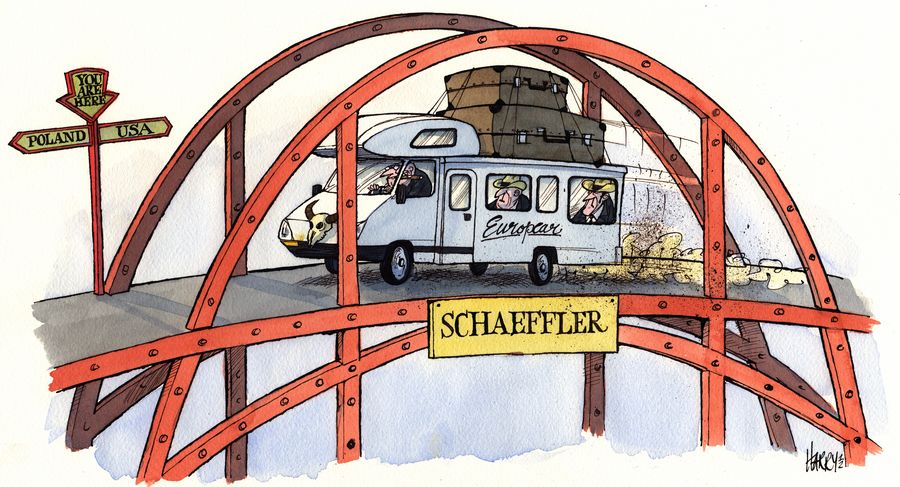A high-yield machine: For reopening the market, leading the charge on jumbo transatlantic deals for debut issuers and leveraged buyouts, and bringing the broadest range of issuers across geographies and credit quality throughout another volatile year dominated by refinancings, Deutsche Bank is IFR’s EMEA High-Yield Bond House of the Year.
To see the full digital edition of the IFR Review of the Year, please <a href="http://edition.pagesuite-professional.co.uk//launch.aspx?eid=24f9e7f4-9d79-4e69-a475-1a3b43fb8580" onclick="window.open(this.href);return false;" onkeypress="window.open(this.href);return false;">click here</a>.
This year may have been another year of growth in the European high-yield bond market with 20% returns up for grabs, but that was by no means obvious in January.
The market had come to a virtual standstill in the second half of 2011, and the last deal to price was in early November. The culprit for the gridlock – the eurozone sovereign crisis – was still raging.
Deutsche Bank faced those problems head-on by reopening the European market with a multi-currency financing for the leveraged buyout of Polish telecoms firm Polkomtel, and followed that up a month later with the biggest global refinancing for a debut issuer with a four-pronged attack for German auto parts supplier Schaeffler – neither of which were straightforward deals.
Among the bank’s other significant trades in those crucial early months, which helped to underpin confidence, was a cross-border transaction for a more familiar high-yield borrower – Fresenius Medical Care – and a US$400m Caa1/B– rated bond which backed the buyout of Belgian specialty chemical company Taminco.
The ability to secure US dollar access for European issuers should not be underestimated, but Deutsche did this with the best interests of its clients in mind.
“There has been a tendency to price deals solely in dollars, and to drop euro tranches when the European markets have been volatile,” said Henrik Johnsson, head of European high-yield capital markets at the bank.
“But we always try to do what is best for our clients, and feel we have really helped to keep the euro market alive by sticking to euros when that is best for issuers.”
At the start of the year, the potential break-up of the euro was the over-riding fear in the market, but European issuers, who face a €250bn leveraged loan mountain to refinance over the next five years, could not sit on their hands.
Deutsche had already established critical US dollar access for peripheral Spanish cable operator ONO in 2011, and it led the charge in 2012.
Johnsson was one of the industry players who spotted the trend early.
“If there is going to be a key theme next year [2012], it will be about accessing the US dollar market in loans and bonds, and then opportunistically in Europe where the market may only be open for limited periods of time over the next six months,” he said in December 2011.
By the time February arrived, 63% of European issuance had come in dollars, and by the end of the year around 30 European issuers had tapped the dollar market with Deutsche as bookrunner on 60% of that volume.
Putting Poland on the map
Deutsche’s role as a global co-ordinator on Polkomtel’s B3/B– rated €900m-equivalent dual-tranche unsecured deal – executed in a challenging market – also stands out.
Deutsche had underwritten the debt for the buyout of the business in June, along with three other banks – Credit Agricole, Royal Bank of Scotland and Societe Generale.
It may have been one of the most lucrative deals of the year in terms of fees, but the money was well earned. Not only was it difficult to structure and sell, but it also required hedging solutions and strong engagement with investors.
One of the most challenging aspects was explaining Poland to US investors at a time when there was so much uncertainty around sovereign credit risk in Europe.
Its size was also eye-catching, marking the largest LBO in Europe since August 2007, and the biggest ever LBO in Central and Eastern Europe.
The financing consisted of €542.5m and US$500m tranches that printed in January, and was followed up a month later by a US$201m payment-in-kind issue, rated Caa1/B–.
Both tranches were more than twice subscribed, priced at the medium to tight end of guidance and traded up 2.5 points on the break.
Schaeffler stuns
Deutsche’s other landmark deal was undoubtedly Schaeffler’s €2bn-equivalent senior secured transatlantic offering, which was upsized from €1bn with final books 10 times subscribed.
Deutsche was left lead on the euro tranche – the largest portion of the dual-currency trade.
“The deal had a very mixed reception when it was announced, but the leads did a very good job,” said one investor.
That “mixed reception” was related to Schaeffler’s debt-fuelled acquisition of Continental just as Lehman Brothers filed for bankruptcy in 2008. The deal is IFR’s EMEA High-Yield Bond of the Year.
Balanced and diverse
The diversity of Deutsche’s issuance also leaves it head and shoulders above its competitors in Europe.
“We’re competing on so many different levels. There are banks that specialise in more esoteric deals and others that are more focused on blue chips,” said Johnsson. “We’ve done both. We printed the lowest and highest coupon deals, in addition to being on the biggest LBOs of the year.”
Deutsche leads the league tables for number of deals as a bookrunner (almost 50 issues), was left-lead bookrunner on around 30% of all non-dollar denominated deals and was the top bookrunner for first-time issuers.
Some of the German bank’s main rivals have more niche franchises, offering esoteric financing solutions, but investors said Deutsche had been amongst the most balanced when it came to serving the interests of both issuers and funds.
The bank achieved record low borrowing costs for some of its higher-rated clients such as Fresenius, and remained dominant in the telecoms and cable arena, acting as bookrunner on 75% of all transactions in the sector including the Polkomtel and ONO, as well as Virgin Media, Wind, Kabel Deutschland, Orange Switzerland and Sunrise.
It also had its fair share of bespoke and challenging deals including a PIK bond for Swedish cable company Com Hem – arguably one of the toughest types of securities to sell in Europe.
Deutsche helped grow the floating-rate note sector, too, acting as a bookrunner on 90% of all FRNs. Those included a refinancing for Lecta – the first non-distressed exchange note to price in Europe post the financial crisis – and the first Swiss franc FRN for Sunrise.
The bank’s tough rescue deals included a Triple C rated bond for car hire company Europcar in volatile conditions in May when rivals pulled deals, and a similarly challenging bond for Northern Irish utility Viridian which was just three months away from default.
Deutsche is unique in that it has still not pulled a deal in Europe since the financial crisis.
The bank may have struggled to offload all of its exposure of Algeco Scotsman, but the steady performance of the senior secured bonds in secondary should make it easier to sell the unsecured bond later down the line.
Separating the wheat from the chaff in the high-yield market is also about having the full package. Few franchises offer the full whammy of primary, research, and sales and trading – expensive for banks, but the stuff that matters for the fund management industry.
The first investor summed it up perfectly. “Deutsche is a machine when it comes to primary issuance. When some banks launch deals, we have to go to them to find out what’s going on. That’s not the case with Deutsche. The sales team also delivers.”



